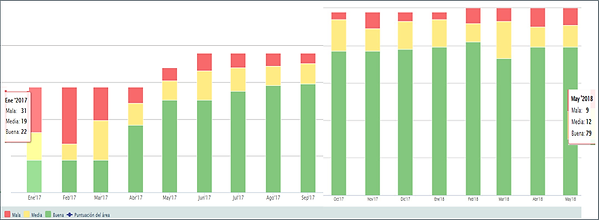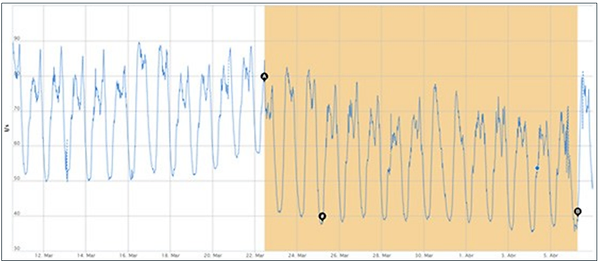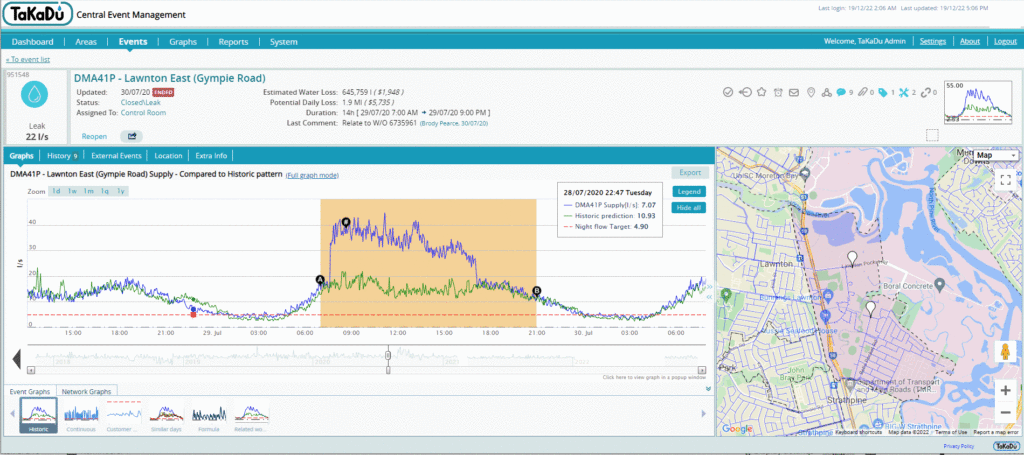
Increasing operational efficiency through network management and improved visibility
Background
Essbio-Nuevosur supplies water to more than one million customers in the VI, VII and VIII regions of Chile with a pipe distribution network of more than 9700 km and a sewage collection network of more than 7800 km. Due to the large number of users it serves and the wide geographical area it covers, the Company constantly faces the challenge of meeting the demand for this essential natural resource, in the context of the region’s growing water shortage.
On the road to operational efficiency
In early 2010, Chile witnessed one of the strongest earthquakes in its history, which had its epicenter precisely in the Essbio-Nuevosur concession area, causing significant damage to its infrastructure. The impact was quickly reflected in the Non-Revenue Water (NRW) indicators, rising from 39% to 42%. With the aim of reducing this rate, the Company implemented a water loss reduction plan with special emphasis on leak detection and repair activities. However, over time, the steps lost their effectiveness, so the Company decided to improve the network’s operational performance and management model.
The new model was based on the best management practices of the international water utility industry, comprising four fundamental pillars:
Pressure management
Continuous network monitoring
Commercial loss management
Network operations management

In 2016, in order to facilitate its strategy, the Company decided to
implement the Central Event Management solution, TaKaDu, supported by its trusted local partner BLASS.
Continuous network monitoring & operations management
Prior to TaKaDu’s implementation, it was hard for the Company to identify problems in the wide variety of sensors deployed in its network. Since day one, TaKaDu has been able to categorize these problems and support decision-making, allowing for timely repairs. Among the problems detected were communication failure, latency, uncalibrated sensors and SCADA integration issues.

The image shows the monthly progress of the monitoring conditions within Essbio-Nuevosur’s drinking water network. The number of areas is shown on the vertical axis, indicating those in good condition as green. In Jan’ 17, only 22 areas were found to have a good monitoring status. By Jul` 19, this number rose to 91 areas.
Reduction in nightline consumption
Working with TaKaDu, it has been possible to detect, quantify and categorize variations in minimum night consumption, mainly caused by leaks. Essbio-Nuevosur operators have planned and prioritized their intervention in each location based on this indicator. In 2017 alone, the Company managed to reduce about 2.000.000 m3, equivalent to about US$180,000 in savings.

The graph shows a specific case in the “Antiguo Lo Miranda” DMA (District Metered Area), where there was a nightline decrease of almost 13 l/s.
Stronger visibility
The increase in network monitoring capabilities has had a relevant impact on operational improvements. An example of this is a tanks overflow event, which occurred in Carampangue on May 20th, 2019.

TaKaDu found that every night the tank was losing at least 3 l/s for six hours. Essbio-Nuevosur has since acted to reverse this situation, modifying the way the pumps are operating.
Early leak & burst detection
In June 2019 alone, TaKaDu detected more than 80 anomalies associated with flow variations. Out of these, more than 20 corresponded to leaks and bursts that were already repaired in the field with the remaining kept under analysis and permanently monitored regarding their evolution and priority. This has allowed Essbio-Nuevosur to increase the efficiency of its teams in the field, shorten repair cycles, reduce water losses, reduce collateral damage and customer complaints.
Another example occurred in the Chimbarongo DMA on June 7th, 2019. A drought-affected area, the Company categorized it as a “Water Risk”, meaning that each drop recovered generates an impact. In this case, a burst of 4.5 l/s, was detected and repaired in less than three days. At the time of its repair, more leaks were found in the field, saving up to 7 l/s in its night flow.

Blue line: real water supply.
Green line: water supply prediction calculated by TaKaDu

Process-focused strategy
A large organization with more than 1,000 employees, Essbio-Nuevosur has different departments constantly interacting with each other, solving the daily challenges imposed by their network, with the aim of delivering the best customer service. As part of its continuous improvement strategy, Essbio-Nuevosur has promoted the necessary adaptation of Processes to obtain the best benefits from its Technological resources, understanding that the involvement of the People is essential to achieve it. As a result, there is a continuous review of the workflow triggered by TaKaDu-detected events.
Summary
TaKaDu has had a significant impact helping Essbio-Nuevosur to reduce water loss through improved operational efficiency, playing an important role in preserving Chile’s scant water resources at a time of regional, and global, climate change.

